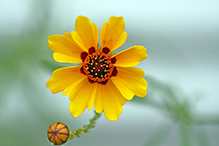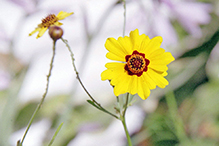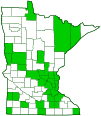plains coreopsis
(Coreopsis tinctoria var. tinctoria)
Conservation • Wetland • Description • Habitat • Ecology • Use • Distribution • Taxonomy
Description |
||
Plains coreopsis is a 12″ to 48″ tall, erect, usually annual, sometimes biennial forb that rises on usually a single stem from a taproot. The stems are erect, ridged, hairless, and much branched above the middle. The leaves are opposite, broadly egg-shaped in outline, ⅝″ to 4″ long, and 3 ⁄16″ to 1″ wide. They are distributed in 6 to 12 pairs along ⅔ or more of the stem. Lower leaves are pinnately divided, bipinnately divided, or rarely 3 times pinnately divided. They are on stalks up to 3⅛″ long. Upper leaves are usually pinnately divided, rarely undivided, and stalkless or almost stalkless. The leaf blades have usually 5 to 25 ultimate segments. The ultimate segments are narrowly linear to linear lance-shaped, ⅜″ to 1¾″ long, and 1 ⁄32″ to ⅛″ wide. They are hairless and are tapered at the base and the tip. The inflorescence is a branched cluster of many flower heads at the ends of the upper branches. The flower heads are 1″ to 2″ wide on stalks ¾″ to 2″ or more long. The involucre is bell-shaped and is composed of 2 series of usually 8 bracts each. The inner bracts are triangular or egg-shaped, ⅛″ to ⅜″ long, and reddish to dark red-brown. The outer bracts are triangular to lance-shaped, 1 ⁄32″ to ⅛″ long, and green, often reddish tinged. There are 6 to 12, usually 8, ray florets and numerous disk florets. The ray florets are ½″ to ¾″ long and yellow with a dark red-brown blotch at the center. They have 3, sometimes 4, shallow lobes at the tip, usually a large central lobe and 2 smaller lateral lobes. The disk is 1 ⁄5″ to ½″ wide. The disk floret is a yellow-orange, 4-lobed corolla tube with a deep purple tip, and a forked style that is orange at the tip and extends beyond the corolla tube. The fruit is an achene that does not have a tuft of hair (pappus) attached. |
||
Height |
||
12″ to 48″ |
||
Flower Color |
||
Yellow with a red-brown center |
||
Similar Species |
||
Other Coreopsis species have flower petals that are yellow throughout. Prairie coreopsis (Coreopsis palmata) is unbranched. The leaves are divided well above the middle into 3 lobes well above the base and have the shape of a turkey foot. The inner bracts on the involucre are yellow-brown. The ray flowers are yellow throughout and have a rounded tip with or without a few tiny teeth at the tip. The disk florets are yellow and the disk appears yellow. |
||
Habitat |
||
Damp, disturbed sites. |
||
Ecology |
||
Flowering |
||
June to August |
||
Pests and Diseases |
||
|
||
Use |
||
Plains coreopsis is widely sold as an ornamental plant for gardens and is also sold as a cut flower. |
||
Distribution |
||||
|
Sources The Global Biodiversity Information Facility (GBIF) has many scattered records throughout Minnesota. All other sources listed here show the plant restricted to the southeast quarter of the state, with just one (USDA PLANTS and BONAP) or a few (iNaturalist) outlying occurrences. The map at left includes the GBIF records. |
|||
| 7/15/2022 | ||||
Nativity |
||||
Native |
||||
Occurrence |
||||
Uncommon in Minnesota |
||||
Taxonomy |
|||
| Kingdom | Plantae (green algae and land plants) | ||
| Subkingdom | Viridiplantae (green plants) | ||
| Infrakingdom | Streptophyta (land plants and green algae) | ||
| Superdivision | Embryophyta (land plants) | ||
| Division | Tracheophyta (vascular plants) | ||
| Subdivision | Spermatophytina (seed plants) | ||
| Class | Magnoliopsida (flowering plants) | ||
| Superorder | Asteranae | ||
Order |
Asterales (sunflowers, bellflowers, fanflowers, and allies) | ||
Family |
Asteraceae (sunflowers, daisies, asters, and allies) | ||
| Subfamily | Asteroideae | ||
| Supertribe | Helianthodae | ||
| Tribe | Coreopsideae (coreopsis and allies) | ||
| Genus | Coreopsis (tickseed) | ||
| Section | Calliopsis | ||
| Species | Coreopsis tinctoria (plains coreopsis) | ||
Subordinate Taxa |
|||
|
|||
Synonyms |
|||
Coreopsis cardaminefolia Coreopsis stenophylla Coreopsis tinctoria var. imminuta |
|||
Common Names |
|||
garden coreopsis golden coreopsis golden tickseed painted tickseed plains coreopsis plains tickseed |
|||
Glossary
Achene
A dry, one-chambered, single-seeded seed capsule, formed from a single carpel, with the seed attached to the membranous outer layer (wall) only by the seed stalk; the wall, formed entirely from the wall of the superior ovary, does not split open at maturity, but relies on decay or predation to release the contents.
Bipinnate
Twice pinnate. Divided into leaflets that are further pinnately divided.
Bract
Modified leaf at the base of a flower stalk, flower cluster, or inflorescence.
Corolla
A collective name for all of the petals of a flower.
Involucre
A whorl of bracts beneath or surrounding a flower, flower head, or flower cluster.
Pappus
The modified calyx composed of awns, scales, bristles, or feather-like hairs in plants of the Aster family such as thistles and dandelions.
Pinnate
On a compound leaf, having the leaflets arranged on opposite sides of a common stalk. On a bryophyte, having branches evenly arranged on opposite sides of a stem.
Visitor Photos |
|||||
Share your photo of this plant. |
|||||
| This button not working for you? Simply email us at info@MinnesotaSeasons.com. Attach one or more photos and, if you like, a caption. |
|||||
|
|||||
MinnesotaSeasons.com Photos |
|||||
 |
 |
||||

Slideshows |
||

Visitor Videos |
|||
Share your video of this plant. |
|||
| This button not working for you? Simply email us at info@MinnesotaSeasons.com. Attach a video, a YouTube link, or a cloud storage link. |
|||
Other Videos |
|||
| ハルシャギク Hidekawa0627 |
|||
About
Published on May 19, 2014 ハルシャギク(波斯菊、学名: Coreopsis tinctoria)は、キク科ハルシャギク属の一年草。空き地や道端などに生え、野生化している。 hidekawa0627(河口秀博)のホームページはhttp://www5a.biglobe.ne.jp/~h-kawa/ |
|||

Visitor Sightings |
|||||
Report a sighting of this plant. |
|||||
| This button not working for you? Simply email us at info@MinnesotaSeasons.com. Be sure to include a location. |
|||||
|
|||||
MinnesotaSeasons.com Sightings |
|||||

|
Created: Last Updated: © MinnesotaSeasons.com. All rights reserved. |
